The Role of Street Elements on the Social Activities of the Elderly in Severe Winter Conditions: A Case Study of Harbin, China
Abstract
1. Introduction
1.1. Social Health Problems of the Elderly
1.2. The Advantages and Necessity of Promoting Streets
1.3. The Influence of Street Elements on the Social Activities of the Elderly
- Are seating and fitness elements associated with higher levels of social activities among the elderly?
- In what ways do road traffic elements impact the social participation of the elderly?
- How does street vegetation affect social activities among the elderly in winter?
2. Materials and Methods
2.1. Study Sites
2.2. Study Procedure
- Passive Social Activities: Non-verbal engagements enabling social learning through environmental co-presence [10].
- Short Social Activities: Brief exchanges during necessary acts (e.g., greetings while shopping), corresponding to Gehl’s ‘transient interactions’.
- Continuous Social Activities: Sustained engagements requiring active participation (e.g., group conversations). Mobile activities (e.g., talking while walking) are analyzed separately due to their distinct spatial dynamics (see Table 4).
2.3. Study Measures
- Stage-aligned sampling: Observation days were randomly selected within each meteorologically defined winter stage, thereby capturing the typical temperature range for each period (from −5 °C to −40 °C).
- Weekday/weekend balance: For each stage, one weekday and one weekend day were sampled to account for variations in routine and social activities.
- Exclusion criteria: Days with extreme weather (e.g., blizzards and visibility < 100 m) or public holidays (e.g., Spring Festival) were excluded, as these disproportionately alter behavior patterns.
2.4. Data Analysis
2.4.1. Spatial Density Analysis
2.4.2. Overlapping Analysis
3. Results
- Corner spaces with rest and fitness elements support continuous social activities such as square dancing and chess, using seats, cushions (brought by the users), trash cans, and tables.
- Intersections serve as sites for passive social activities, such as waiting at traffic lights.
- Residential entrances/exits see passive social activities like sitting and resting and continuous social activities like walking together.
- Spaces with vegetation, such as trees, pavilions, seats, and flower planters, support short activities like dog walking and passive social activities like sitting and resting.
3.1. Characteristics of Social Activities of the Elderly
3.1.1. Quantitative Characteristics
3.1.2. Spatial Characteristics
3.2. Fitting of Activities According to Rest Fitness Elements, Spatial Pattern, and Stages of Winter
3.2.1. Early Winter Stage
3.2.2. Severe Winter Stage
3.2.3. Late Winter Stage
3.3. Road Traffic Elements and the Social Activities of the Elderly
3.3.1. Early Winter Stage
3.3.2. Severe Winter Stage
3.3.3. Late Winter Stage
3.4. Green Landscape Elements Impact on the Social Activities of the Elderly
3.4.1. Early Winter Stage
3.4.2. Severe Winter Stage
3.4.3. Late Winter Stage
4. Discussion
4.1. Rest Fitness Elements: Microclimate Adaptation and Material Selection
4.2. Road Traffic Elements: Safety Orientation and Functional Composite
4.3. Green Landscape Elements: Seasonal Adaptive Design and Ecological Function
4.4. Comprehensive Optimization Strategy of Elements
4.5. International Comparative Perspective
4.6. Study Limitations and Future Directions
5. Conclusions
Author Contributions
Funding
Data Availability Statement
Acknowledgments
Conflicts of Interest
References
- United Nations. Available online: https://www.un.org/en/global-issues (accessed on 25 April 2024).
- Li, S.; Zhu, C.; Deng, X. Exploring the urban–rural gradient effects of construction land expansion processes on land use function trade-off/synergy in rapidly urbanizing areas. Land Degrad. Dev. 2024, 35, 46–61. [Google Scholar] [CrossRef]
- Hongke, Z. Exploring the social adaptation of the elderly from the perspective of active aging. Adv. Psychol. 2023, 13, 2603–2611. [Google Scholar] [CrossRef]
- Xiong, X.; Wang, J.; Wu, H.; Peng, Z. The Influence of Perceptions of the Park Environment on the Health of the Elderly: The Mediating Role of Social Interaction. ISPRS Int. J. Geo-Inf. 2024, 13, 262. [Google Scholar] [CrossRef]
- Yin, Q.; Cao, Y.; Sun, C. Research on outdoor thermal comfort of high-density urban center in severe cold area. Build. Environ. 2021, 200, 107938. [Google Scholar] [CrossRef]
- Ling, Z.; Zheng, X.; Chen, Y.; Qian, Q.; Zheng, Z.; Meng, X.; Kuang, J.; Chen, J.; Yang, N.; Shi, X. The Nonlinear Relationship and Synergistic Effects between Built Environment and Urban Vitality at the Neighborhood Scale: A Case Study of Guangzhou’s Central Urban Area. Remote Sens. 2021, 16, 2826. [Google Scholar] [CrossRef]
- Leng, H.; Han, B. Effect of Environmental Planning on Elderly Individual Quality of Life in Severe Cold Regions: A Case Study in Northeastern China. Sustainability 2022, 14, 3522. [Google Scholar] [CrossRef]
- Lebel, A. Winter Cities and Aging Populations: Planning for Mobility and Social Inclusion in Canadian Urban Centers. J. Aging Environ. 2020, 34, 145–162. [Google Scholar]
- Nygård, M.; Jakobsson, K. Nordic Welfare Systems and Seasonal Challenges for Older Adults: Lessons from Sweden and Finland. Scand. J. Soc. Policy 2021, 49, 301–318. [Google Scholar]
- Mehta, V. The Street: A Quintessential Social Public Space; Routledge: Abingdon, UK, 2013. [Google Scholar]
- Benach, J. We must take advantage of this pandemic to make a radical social change: The coronavirus as a global health, inequality, and eco-social problem. Int. J. Health Serv. 2021, 51, 50–54. [Google Scholar] [CrossRef] [PubMed]
- Wang, J.; Cui, C.; Tian, T. Optimal tactics in community pension model for defined benefit pension plans. PLoS ONE 2025, 20, e0300766. [Google Scholar] [CrossRef]
- Yuan, Q.; Zhao, J.; Leng, H. Study on the selection of outdoor activity places for the elderly in winter-Taking Harbin as an example. Low Temp. Build. Technol. 2021, 43, 1–6. [Google Scholar]
- Woolrych, R.; Sixsmith, J.; Fisher, J.; Makita, M.; Lawthom, R.; Murray, M. Constructing and negotiating social participation in old age: Experiences of older adults living in urban environments in the United Kingdom. Ageing Soc. 2021, 41, 1398–1420. [Google Scholar] [CrossRef]
- Zhang, Y.; Chen, G.; He, Y.; Jiang, X.; Xue, C. Social interaction in public spaces and well-being among elderly women: Towards age-friendly urban environments. Int. J. Environ. Res. Public Health 2022, 19, 746. [Google Scholar] [CrossRef]
- Brunelli, L. Older People’s Everyday Life and Well-Being at the Local High Street: A Study of Local Town Centres in Edinburgh. Ph.D. Thesis, Heriot-Watt University, Edinburgh, UK, 2020. [Google Scholar]
- Rapoport, A. Cold, Climate, and Culture. J. Winter Environ. 2023, 12, 45–60. [Google Scholar]
- Wu, Y.; Zhou, W.; Zhang, H.; Liu, Q.; Yan, Z.; Lan, S. Relationships between Green Space Perceptions, Green Space Use, and the Multidimensional Health of Older People: A Case Study of Fuzhou, China. Buildings 2024, 14, 1544. [Google Scholar] [CrossRef]
- Ugolini, F.; Massetti, L.; Calaza-Martínez, P.; Cariñanos, P.; Dobbs, C.; Ostoić, S.K.; Marin, A.; Pearlmutter, D.; Saaroni, H.; Sauliene, I.; et al. Understanding the benefits of public urban green space: How do perceptions vary between professionals and users? Landsc. Urban Plan. 2022, 228, 104575. [Google Scholar] [CrossRef]
- Xu, S.; Wang, Y. Influence of spatial scale on the study of access fairness of urban park green space. Front. Environ. Sci. 2023, 10, 1030796. [Google Scholar] [CrossRef]
- Cardinali, M.; Beenackers, M.A.; Van, T.A.; Pottgiesser, U. Preferred reporting items in green space health research. Guiding principles for an interdisciplinary field. Environ. Res. 2023, 228, 115893. [Google Scholar] [CrossRef] [PubMed]
- Shao, Y.; Yin, Y.; Xue, Z.; Ma, D. Assessing and comparing the visual comfort of streets across four Chinese megacities using ai-based image analysis and the perceptive evaluation method. Land 2023, 12, 834. [Google Scholar] [CrossRef]
- Leng, H.; Zhang, X.; Yuan, Q. Research progress on the impact of neighborhood environment on the quality of life of the elderly. West. J. Hum. Settl. 2025, 39, 40–49. [Google Scholar]
- Wu, Y.; Wu, Q.; Wu, Y.; Ding, Z. Research on the protection strategy of residential historical and cultural blocks under the concept of multi-factor collaborative renewal-Taking Tongxing Community in Shantang, Suzhou as an example. West. J. Hum. Settl. 2024, 39, 127–133. [Google Scholar]
- Mehdizadeh, M.; Kroesen, M. Does perceived accessibility affect travel behavior or vice versa? Alternative theories testing bidirectional effects and (in) consistency over time. Transp. Res. Part A Policy Pract. 2025, 191, 104318. [Google Scholar] [CrossRef]
- Sisson, L.N.; Block, S.J.; Triece, T.; Martin, E.M.; Owczarzak, J.; Sherman, S.G.; Schneider, K.E. “It always needs a higher level of care than what I can provide”: Practical, ethical, and administrative tensions arising from the integration of wound care services into syringe service programs in Maryland. Int. J. Drug Policy 2025, 135, 104685. [Google Scholar] [CrossRef]
- Yang, Y.; Tang, S. Assessment of Service Quality in Urban Sports Facilities: A Comprehensive Evaluation Framework Applied to Shanghai, China. Buildings 2025, 15, 193. [Google Scholar] [CrossRef]
- Gehl, J. Life Between Buildings; Island Press: Washington, DC, USA, 2011. [Google Scholar]
- Rodrigues, F.; Domingos, C.; Monteiro, D.; Morouço, P. A review on aging, sarcopenia, falls, and resistance training in community-dwelling older adults. Int. J. Environ. Res. Public Health 2022, 19, 874. [Google Scholar] [CrossRef] [PubMed]
- Whyte, W.H. The Social Life of Small Urban Spaces; Conservation Foundation: Washington, DC, USA, 1980; Volume 116. [Google Scholar]
- Guo, D.; Chen, Y.; Yang, J.; Tan, Y.H.; Zhang, C.; Chen, Z. Planning and application of underground logistics systems in new cities and districts in China. Tunn. Undergr. Space Technol. 2021, 113, 103947. [Google Scholar] [CrossRef]
- Torku, A.; Chan, A.P.C.; Yung, E.H.K. Age-friendly cities and communities: A review and future directions. Ageing Soc. 2021, 41, 2242–2279. [Google Scholar] [CrossRef]
- Gao, W.; Li, Y.; Zhao, M.; Gao, Y.; Zhen, W.; Ouyang, Y. Accessibility analysis of urban public service elements in Beijing based on the perspective of supply and demand of TOD station domain. J. Peking Univ. 2025, 10, 1–15. [Google Scholar]
- Lu, C.; Wu, W.; Han, D. Understanding the spatial distribution and behavior of elderly residents in age-friendly communities: An analysis of outdoor space features in Hangzhou, China. Sustainability 2023, 15, 10703. [Google Scholar] [CrossRef]
- Vargas-Hernández, J.G.; Pallagst, K.; Zdunek-Wielgołaska, J. Urban Green Spaces as a Component of an Ecosystem. In Sustainable Development and Environmental Stewardship: Global Initiatives Towards Engaged Sustainability; Springer International Publishing: Cham, Switzerland, 2023; pp. 165–198. [Google Scholar]
- Irvine, K.N.; Fisher, D.; Marselle, M.R.; Currie, M.; Colley, K.; Warber, S.L. Social isolation in older adults: A qualitative study on the social dimensions of group outdoor health walks. Int. J. Environ. Res. Public Health 2022, 19, 5353. [Google Scholar] [CrossRef]
- Yu, Y.; Jiang, Y.; Li, L. Health approach of urban public space: The connotation, elements and framework of healthy streets. Chin. Gard. 2021, 37, 20–25. [Google Scholar]
- Wang, X.; Yang, D. How does the built environment affect the use frequency of green space for the elderly Based on the dual perspectives of accessibility and attractiveness. China Gard. 2020, 36, 62–66. [Google Scholar]
- Sun, D.; Ji, X.; Lyu, M.; Fu, Y.; Gao, W. Evaluation and diagnosis for the pedestrian quality of service in urban riverfront streets. J. Clean. Prod. 2024, 452, 142090. [Google Scholar] [CrossRef]
- Sun, Z.; Scott, I.; Bell, S.; Yang, Y.; Yang, Z. Exploring dynamic street vendors and pedestrians through the lens of static spatial configuration in Yuncheng. China. Remote Sens. 2022, 14, 2065. [Google Scholar] [CrossRef]




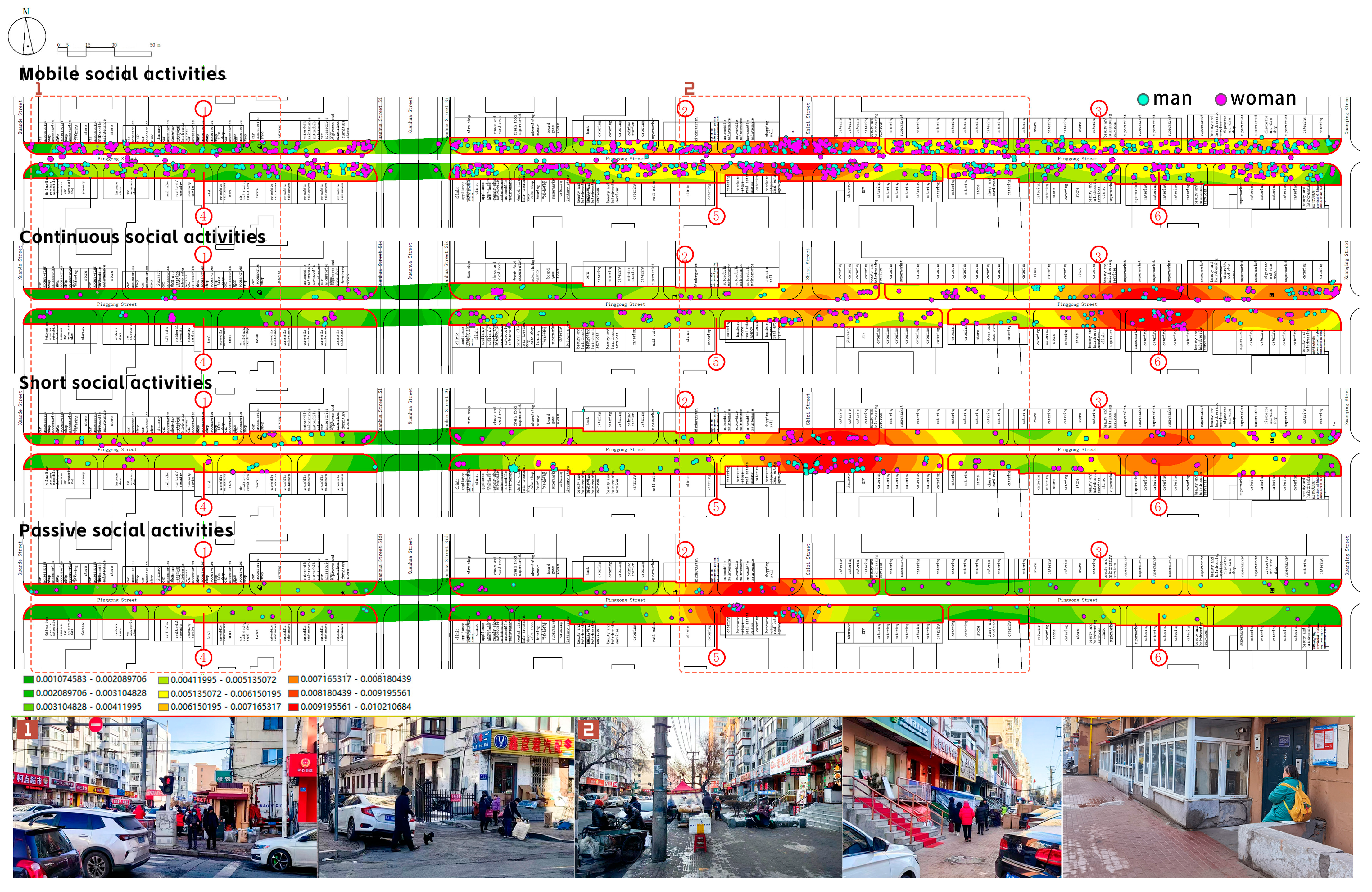
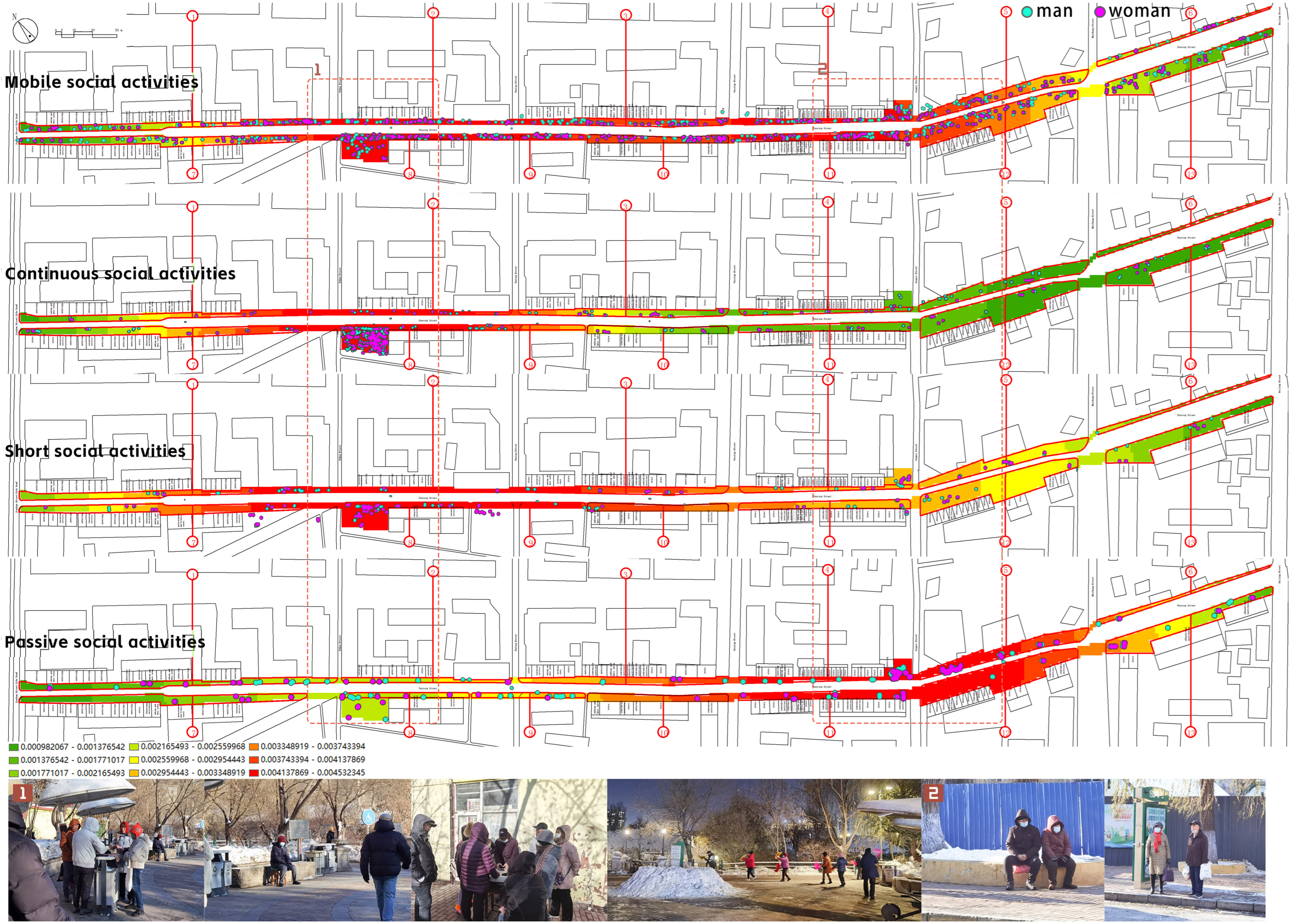
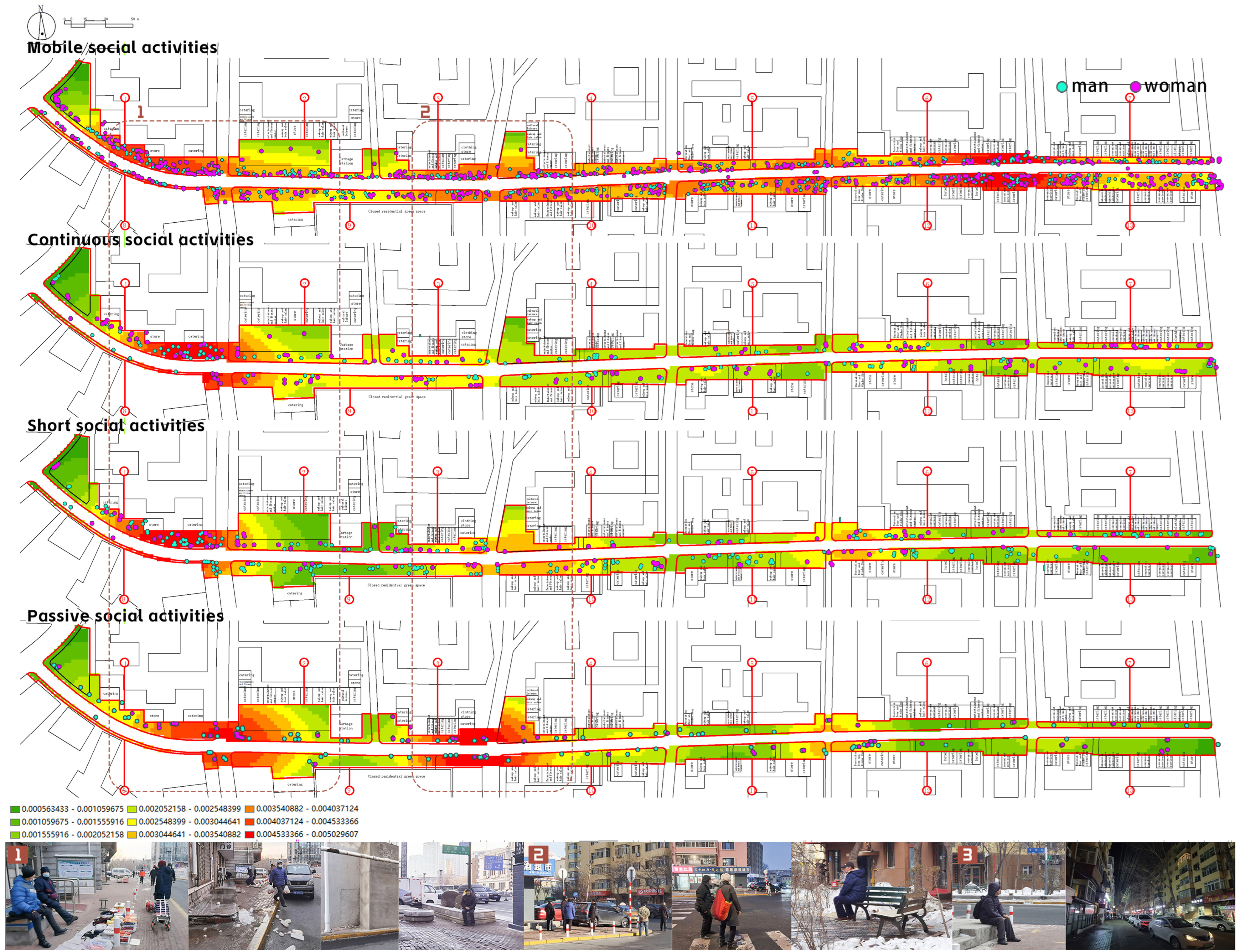

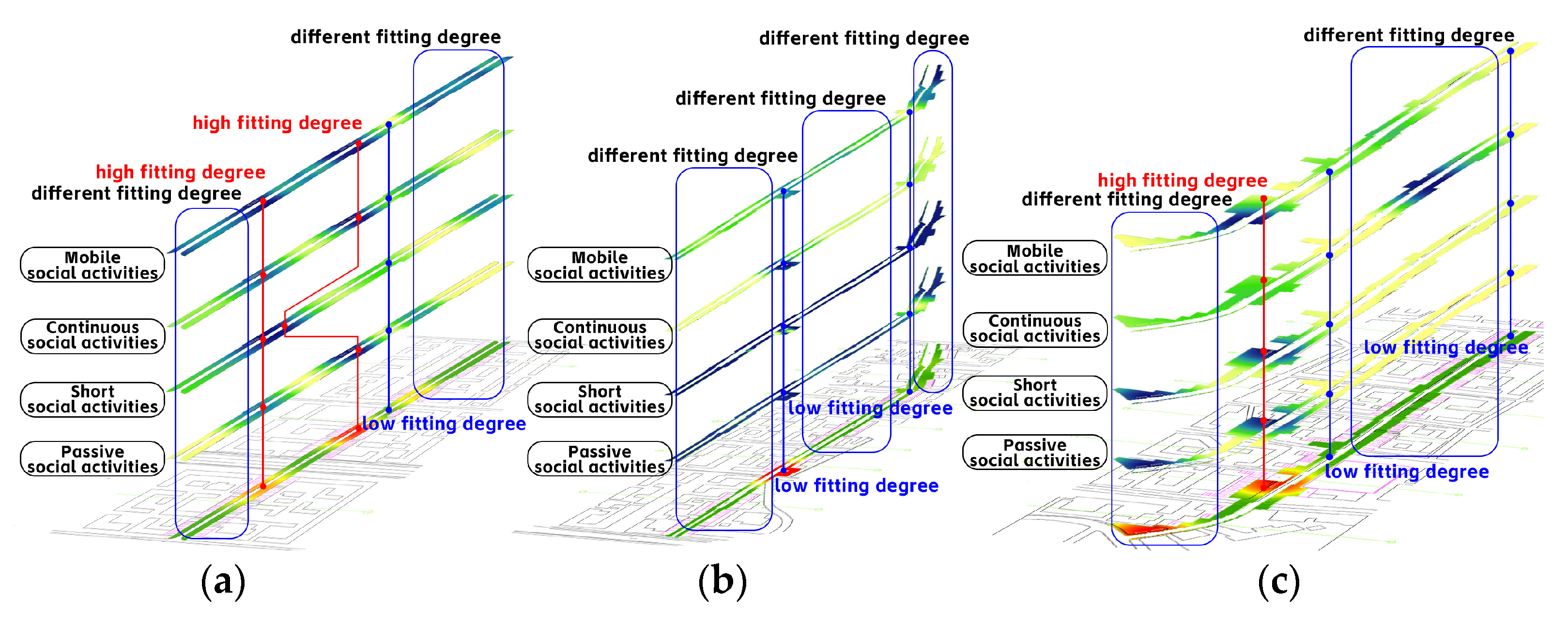
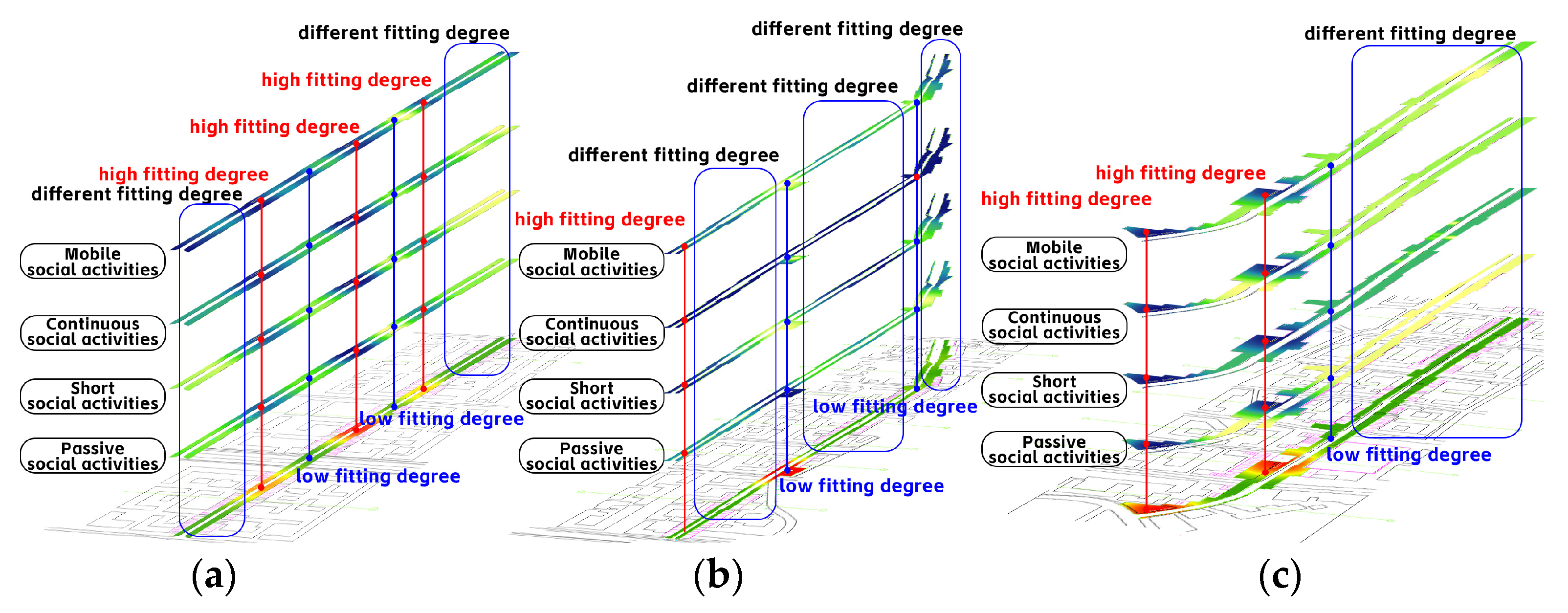

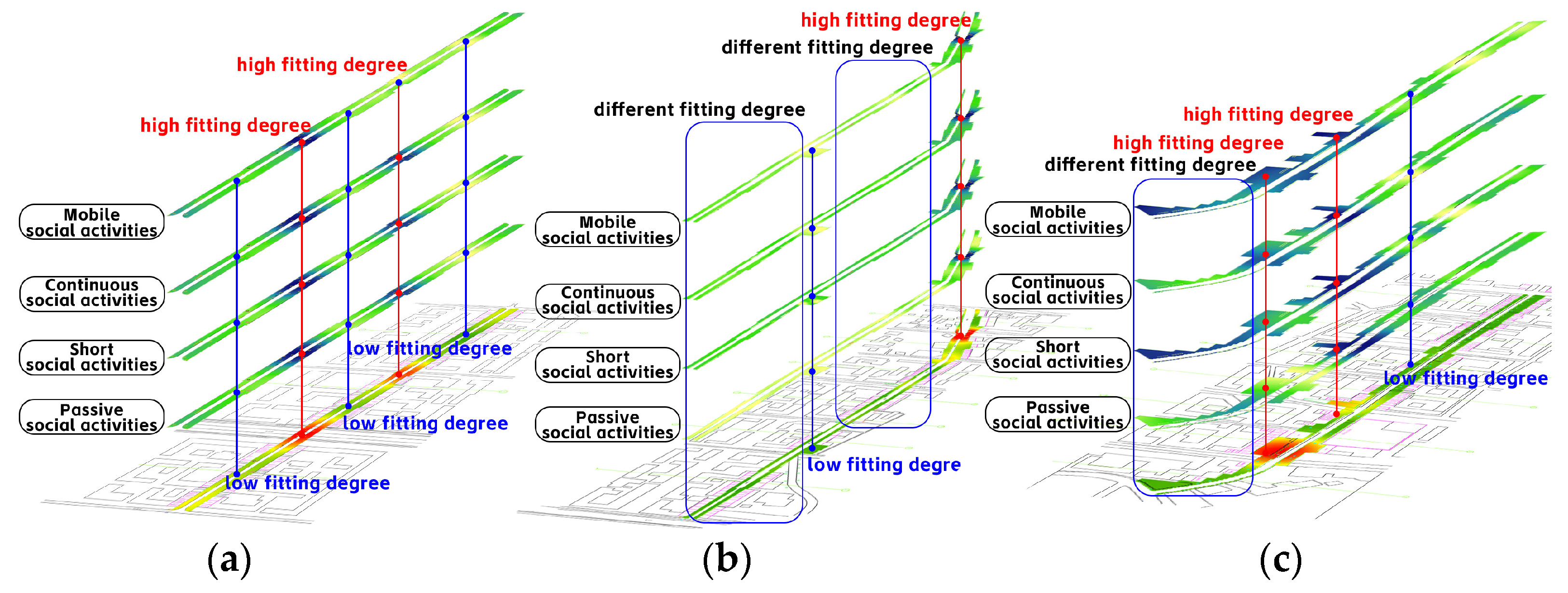

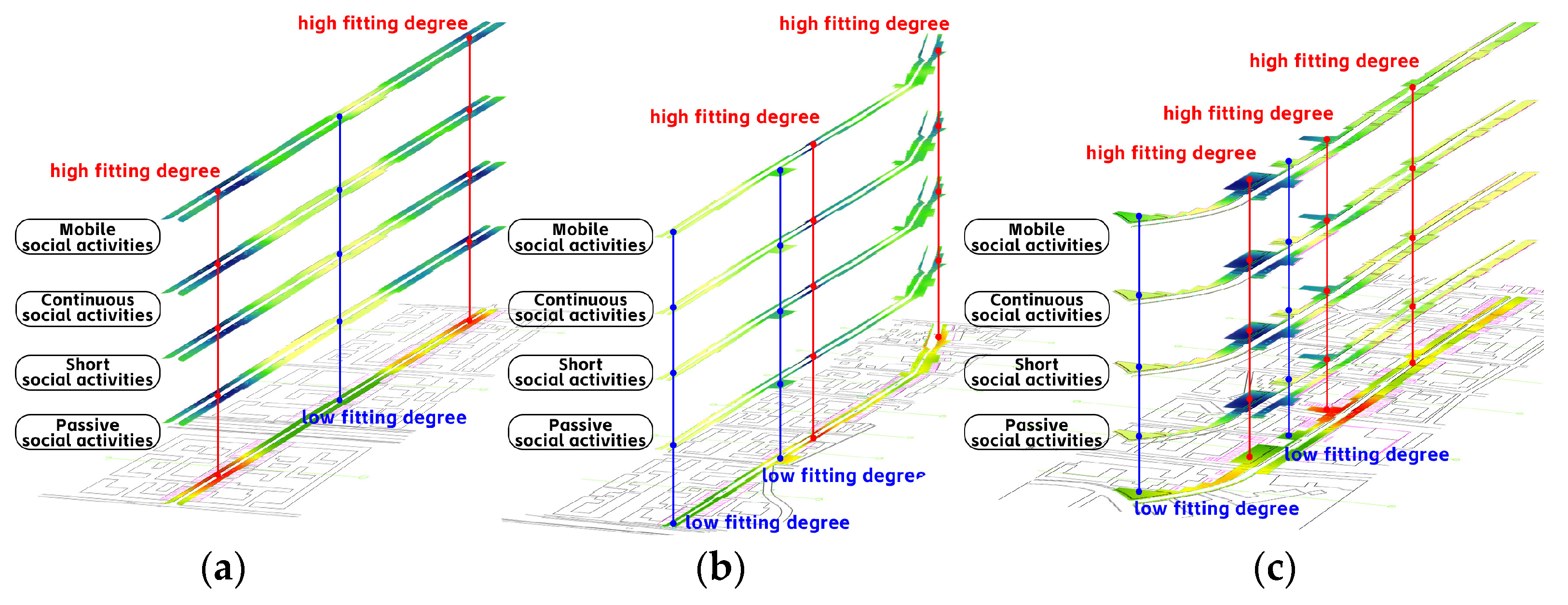
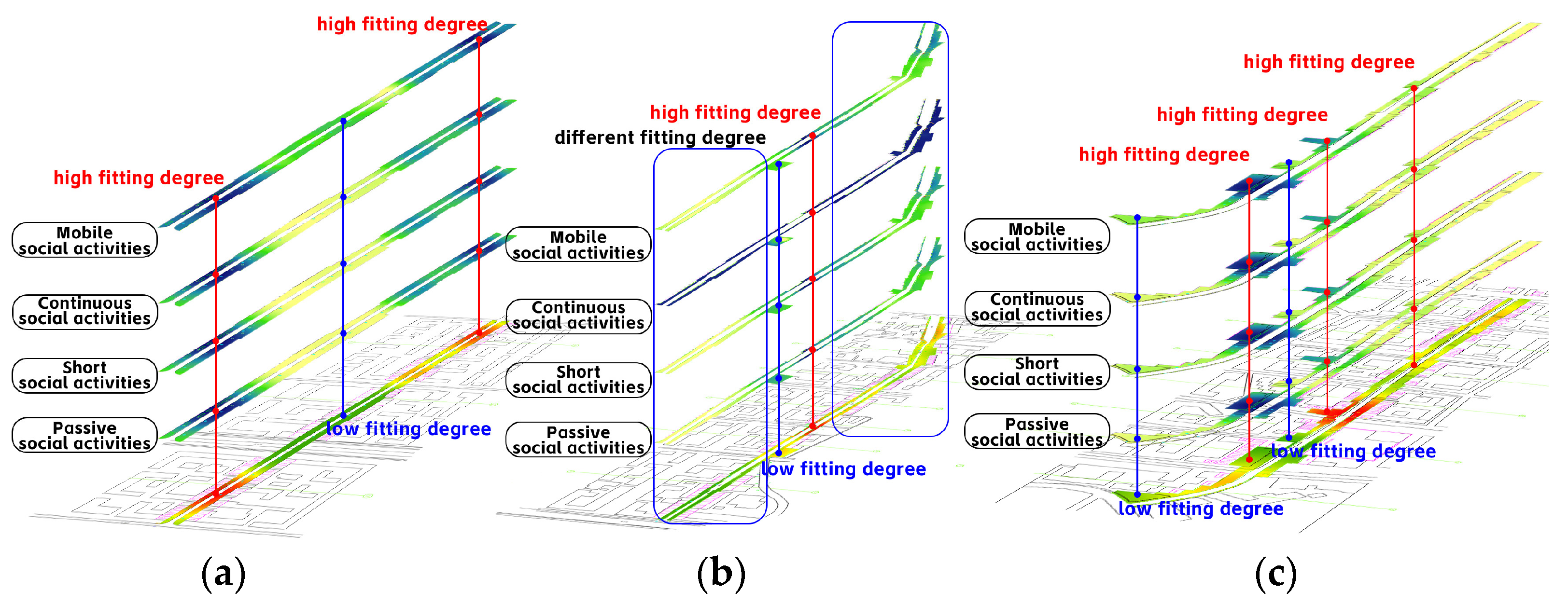

| Climate Zone | Representative Regions/Countries | No. of Studies | Key References |
|---|---|---|---|
| Temperate | Southern China, Italy, UK, Australia | 37 (82.2%) | [10,11,12,13,14,15,16,17,18,19,20,21,22,23,24,25,26,27,28,29,30] |
| Cold High-Latitude | Canada, Scandinavia, Northeastern China | 5 (11.1%) | [8,9,10,13] |
| Other Climates | Tropical, Arid | 3 (6.7%) | [31,32,33] |
| Total | 45 |
| Streets | Pinggong Street | Fanrong Street | Anshun Street |
|---|---|---|---|
| Administrative division | Nangang district | Nangang district | Daoli district |
| Lane characteristics | Single lane | Double lane | Double lane |
| Street length | 750 m (6 street segments) | 1000 m (12 street segments) | 950 m (13 street segments) |
| Function distribution | The north side of the street is mainly residential, and the south side of the street is mainly commercial. | Residential areas are mainly distributed among schools and businesses. | Mainly residential. |
| Street Elements | Definition | Example |
|---|---|---|
| Rest fitness elements | They refer to elements such as chair corridors for people to rest, communicate, and watch in densely populated blocks, such as commercial living blocks. | Seats, fitness equipment, corridors, etc. |
| Road traffic elements | They refer to the furniture on the street used to organize traffic, ranging from parking lots and pedestrian overpasses to bicycle parking spots. | Bus stations, subway stations, overpasses, signal lights, etc. |
| Green landscape elements | They refer to street landscape elements that can create urban cultural atmosphere for people in addition to meeting basic needs. | Street trees, shrubs, landscape sketches, art paving, flowerbeds, sculptures, fountains, stage venues, etc. |
| Types of Social Activities | Definition | Example |
|---|---|---|
| Mobile social activities | Activities on foot for transport, generally with walking as the main focus. | Talking and playing with parents, friends, and neighbors during commuting, walking, jogging, and running. |
| Continuous social activities | Communication activity of low contact intensity with others, involving generally no communication through language and action. | Resting alone, stopping to look (at merchandise, billboards, other people, or window displays), playing musical instruments, humming, eating, reading, working, using mobile phones, etc. |
| Short social activities | Communication activity of medium contact intensity, involving static and moderate direct communication with others and short duration activities. | Greetings, nodding to people, short conversations caused by accidental encounters with neighbors, and chatting between shopkeepers and customers during shopping. |
| Passive social activities | Communication activity with high contact intensity, which occurs in the process of dynamic walking and static presence in the street. Lots of talking and activities with a longer duration | Many people having parallel conversations, neighbors gathered to sit and talk or to play chess and card activities, group business activities, square dancing, exercise, eating, or street performances. |
| Winter Stage | Cold Levels | Definition |
|---|---|---|
| Severe winter (December, January, February) | Grade 1 | “extreme cold,” with temperatures below −40 °C |
| Grade 2 | “severe cold,” with temperatures ranging from −30 °C to −39.9 °C | |
| Late winter (March) | Grade 3 | “cold,” with temperatures ranging from −20 °C to −29.9 °C |
| Grade 4 | “great cold,” with temperatures ranging from −10 °C to −19.9 °C | |
| Grade 5 | “minor cold,” with temperatures ranging from −5 °C to −9.9 °C | |
| Early winter (November) | Grade 6 | “light cold,” with temperatures ranging from 0 °C to −4.9 °C |
| Grade 7 | “slight cold,” with temperatures ranging from 0 °C to 4.9 °C | |
| Grade 8 | “cool,” with temperatures ranging from 5 °C to 9.9 °C |
| Early Winter Stage | Severe Winter Stage | Late Winter Stage | |
|---|---|---|---|
| 7:00–9:00 | 175 | 90 | 84 |
| 9:00–11:00 | 168 | 67 | 86 |
| 11:00–13:00 | 237 | 54 | 120 |
| 13:00–15:00 | 264 | 65 | 125 |
| 15:00–17:00 | 221 | 77 | 124 |
| 17:00–19:00 | 111 | 99 | 78 |
| 19:00–21:00 | 58 | 43 | 81 |
| Total | 1234 | 495 | 698 |
| Early Winter Stage | Severe Winter Stage | Late Winter Stage | |
|---|---|---|---|
| 7:00–9:00 | 64 | 58 | 116 |
| 9:00–11:00 | 93 | 87 | 148 |
| 11:00–13:00 | 163 | 122 | 141 |
| 13:00–15:00 | 168 | 156 | 186 |
| 15:00–17:00 | 118 | 106 | 258 |
| 17:00–19:00 | 90 | 70 | 108 |
| 19:00–21:00 | 72 | 32 | 70 |
| Total | 768 | 631 | 1027 |
| Early Winter Stage | Severe Winter Stage | Late Winter Stage | |
|---|---|---|---|
| 7:00–9:00 | 244 | 120 | 119 |
| 9:00–11:00 | 187 | 59 | 74 |
| 11:00–13:00 | 120 | 40 | 69 |
| 13:00–15:00 | 123 | 61 | 99 |
| 15:00–17:00 | 82 | 90 | 110 |
| 17:00–19:00 | 87 | 54 | 86 |
| 19:00–21:00 | 57 | 35 | 66 |
| Total | 900 | 459 | 623 |
| Pinggong Street | Fanrong Street | Anshun Street | |
|---|---|---|---|
| Mobile social activities | Friends talk and walk | Walking hand in hand | Talking with friends and family, taking a walk, shopping, and returning |
| Continuous social activities | Talking while waiting for the cars to pass, watching the loading and unloading of goods, watching snow shoveling | Waiting for cars to chat, square dancing, chess and card games, fitness | Chatting while waiting for the car, watching loading and unloading goods, watching snow shoveling, outdoor conversation, multiple people chatting in parallel |
| Short social activities | Shopping, child walking, pet walking, waste collection, express delivery communication | Strolling with children, walking with pets, greeting, and chatting by chance | Shopping transactions, greeting, casual conversations, asking for directions, walking with children, walking with pets, collecting waste, picking up express delivery for communication |
| Passive social activities | Shop owners observing, observing while waiting, waiting for the bus, sweeping snow | Sitting in the sun, waiting for the bus | Singing alone, sitting and resting to observe, stopping to look at small stalls, answering and making phone calls, stopping to look at mobile phones, waiting for buses |
| Gathering Location | Street Elements | Social Activities |
|---|---|---|
| Residential entrances and exits | Stairs, flower containers | Say hello, chat with relatives, friends, and neighbors, wait and see, purchase goods |
| In front of shops | Steps, flower beds, roadside trees, roadblock stones, signs | Say hello, purchase goods, chat, wait for the bus to observe, inquire, promote products, smoke and communicate |
| Mobile vendors | Street trees, flower containers | Purchase products, observe and wait |
| Square | Fitness and amusement elements, flower beds, public seats, trash cans | Square dancing, playing musical instruments, practicing Tai Chi, watching, sitting or standing chatting, walking and chatting, greeting, walking dogs for communication, chess and card games |
| Street corner space | Fitness and amusement elements, public seats, trash cans | Sitting and observing, greeting, inquiring, waiting for others to observe, waiting for red lights to chat, hairdressing services, purchasing goods, chatting with friends and neighbors |
| Intersection | Traffic lights, roadblocks, signs | Stop and wait |
| Bus stop | Public seating | Observe, chat, and inquire |
Disclaimer/Publisher’s Note: The statements, opinions and data contained in all publications are solely those of the individual author(s) and contributor(s) and not of MDPI and/or the editor(s). MDPI and/or the editor(s) disclaim responsibility for any injury to people or property resulting from any ideas, methods, instructions or products referred to in the content. |
© 2025 by the authors. Licensee MDPI, Basel, Switzerland. This article is an open access article distributed under the terms and conditions of the Creative Commons Attribution (CC BY) license (https://creativecommons.org/licenses/by/4.0/).
Share and Cite
Yang, K.; Xu, Y.; Wang, M.; Bell, S.; Yu, Y. The Role of Street Elements on the Social Activities of the Elderly in Severe Winter Conditions: A Case Study of Harbin, China. Buildings 2025, 15, 3079. https://doi.org/10.3390/buildings15173079
Yang K, Xu Y, Wang M, Bell S, Yu Y. The Role of Street Elements on the Social Activities of the Elderly in Severe Winter Conditions: A Case Study of Harbin, China. Buildings. 2025; 15(17):3079. https://doi.org/10.3390/buildings15173079
Chicago/Turabian StyleYang, Kexin, Ying Xu, Mengda Wang, Simon Bell, and Yang Yu. 2025. "The Role of Street Elements on the Social Activities of the Elderly in Severe Winter Conditions: A Case Study of Harbin, China" Buildings 15, no. 17: 3079. https://doi.org/10.3390/buildings15173079
APA StyleYang, K., Xu, Y., Wang, M., Bell, S., & Yu, Y. (2025). The Role of Street Elements on the Social Activities of the Elderly in Severe Winter Conditions: A Case Study of Harbin, China. Buildings, 15(17), 3079. https://doi.org/10.3390/buildings15173079






